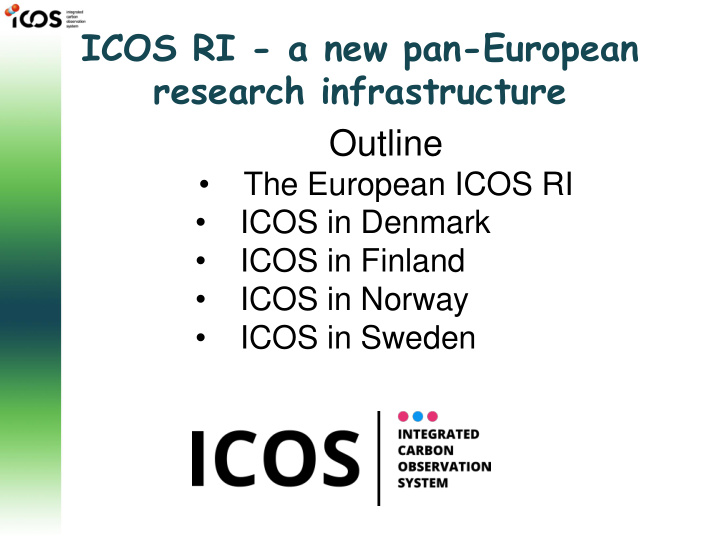



ICOS RI - a new pan-European research infrastructure Outline • The European ICOS RI ICOS in Denmark • • ICOS in Finland ICOS in Norway • • ICOS in Sweden
ICOS history and future 2008 - 2012 2012 - 2015 2015 -
What is ICOS? Integrated Carbon Observation System “A pan -European research infrastructure for quantifying and understanding the greenhouse gas balance of the European continent and adjacent regions”
ICOS objectives • To establish an integrated long-term research infrastructure to understand the biogeochemical cycles of greenhouse gases (and energy) • To determine regional GHG fluxes from observations and attribute these to processes • To enable early detection of climate related surprises • To provide regional GHG budgets for policy support • To provide access and services for data and data products
A vision for the ICOS network Estimated network: • 60 ecosystem stations • 30 atmospheric station
A vision for the ICOS network
Ecosystem stations • Principle: eddy covariance systems measuring turbulent fluxes at the ecosystem level • New understanding of ecosystem exchange of CO 2 , CH 4 , N 2 O, H 2 O and energy • Upscaling of processes in time and space using models and remote sensing assets • Need representative coverage of ecosystems / climate / management regimes • Complementary in situ measurements of ecosystem properties and carbon pools
Atmospheric stations The knowledge challenge • Principle: the atmosphere is a fast but incomplete mixer of surface sources and sinks • High accuracy, long-term monitoring of CO 2 , CH 4 , H 2 O concentrations in boundary layer • Continuous measurements and flask sampling • Atmosphere transport models are used to “invert” concentrations into sources and sinks in space & time • Innovative methodologies using tracers and isotopes help to attribute GHG sources to fossil, oceanic, and terrestrial processes
Ocean stations The knowledge challenge • The ICOS marine observation system will consist of approximately 15 major instrumented “ships of opportunity” and 15 fixed time series stations. • The ships will usually be commercial ships operating regularly repeated routes, e.g. ferry routes in European shelf and marginal seas, and cargo vessels on open ocean routes. • The fixed time series will be points in the ocean at which sustained time series observations are recorded by means of moorings and research ship monitoring.
Observations constrain models in space and time!
Synthesis data products • Current state-of-the-art CO 2 flux maps (from Carboscope): ca 100 km resolution, monthly • With the fully implemented ICOS network: High resolution (25 km, weekly) greenhouse gas (CO 2 , methane...) flux maps for all of Europe
ICOS RI organization - a network built around common thematic centers ICOS ERIC (starting spring 2015) Operated centrally National level
ICOS Head office Helsinki, Finland • Management of the legal entity ICOS ERIC • Budget of ICOS RI • Strategic scientific and technical planning • Community building, outreach, promotion, training • Director General of ICOS ERIC + 7-8 staff • www.icos-infrastructure.eu
ICOS Carbon portal Lund, Sweden Director + 7-8 staff
ICOS RI components ICOS ERIC Head office – Finland & France Carbon Portal – Sweden & the Netherlands Contracts Atmospheric Thematic Centre – France & Finland Ecosystem Thematic Centre – Italy, France & Belgium Ocean Thematic Centre – Norway & UK Central Analytical Laboratory – Germany Observation Networks – 16 countries (tentative)
ICOS Denmark components • 2008-2009: Nationally funded Pre-project (72 k € ) • Identify suitable locations in Denmark • Identify research opportunities by use of ICOS data • Provide information for decision on Danish participation in ICOS. • Funding possibilities: • National Research Councils • Ministries • Private foundations • Industry sponsors • Implementation in DK: • 2 flux stations (1 existing: forest, 1 new: energy crop) • 2 atmospheric concentration stations (tall towers, existing) • 1 oceanic station (research vessel)?
Danish ICOS sites (proposed) Skjern enge
ICOS Finland components ATM: Class 1: Utö, Hyytiälä Class 2: Puijo, Pallas. Class 1 ECO: Hyytiälä, Sodankylä (forest) Class 2 ECO: Siikaneva, Lompolojänkkä (wetland) Associate ECO: Kuivajärvi (lake) Kaamanen (wetland) Lettosuo (wetland) Värriö (forest) Kenttärova (forest) Helsinki (urban)
MobileLab 416 Picarro-main inlet CO 2 Picarro-spare inlet 414 Picarro-UH o Hyytiälä already audited 25.2.- FTIR 412 21.4. 410 o Next audit at OPE, France 10.6.- ppm 408 5.8. 406 404 Preliminary results from Hyytiälä 402 27.2 28.2 1.3 2.3 3.3 4.3 5.3 6.3 7.3 8.3 9.3 o CO 2 , CH 4 & CO measured with 2020 Picarro-main inlet CH 4 Picarro-spare inlet MobileLab Picarro & FTIR Picarro-UH 2000 o Two inlet lines also compared FTIR 1980 o UH Picarro measured CO 2 & CH 4 ppb 1960 1940 1920 1900 27.2 28.2 1.3 2.3 3.3 4.3 5.3 6.3 7.3 8.3 9.3 Hermanni Aaltonen
ICOS Norway components Pending application
The Ocean Thematic Centre ICOS-OTC, Second meeting 22.05.2014 PML
ICOS Sweden components • 6 ecosystem stations: Subarctic mire - Stordalen Boreal mire - Degerö Pine/Spruce- Svartberget Pine/Spruce – Norunda Spruce – Hyltemossa Agricultural site – Lanna • 3 atmospheric stations: North Sweden - Svartberget Central Sweden - Norunda South Sweden – Hyltemossa • 1 marine station: Baltic sea - Östergarnsholm • A “national resource”: collect ICOS data long-term monitoring serve as ”bases” for other research projects
Recommend
More recommend